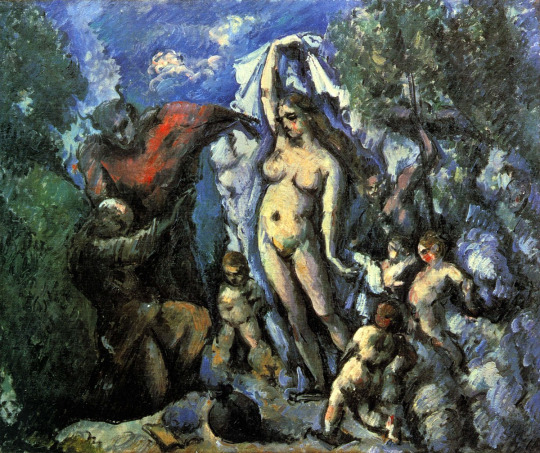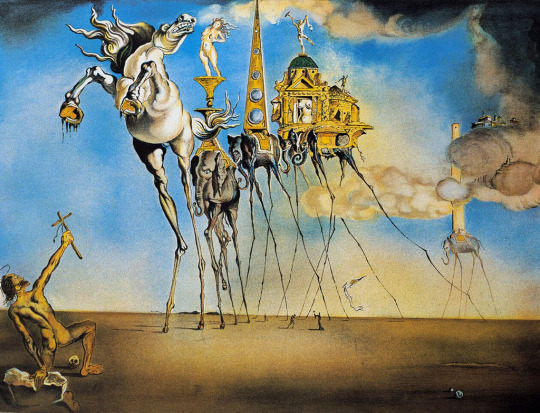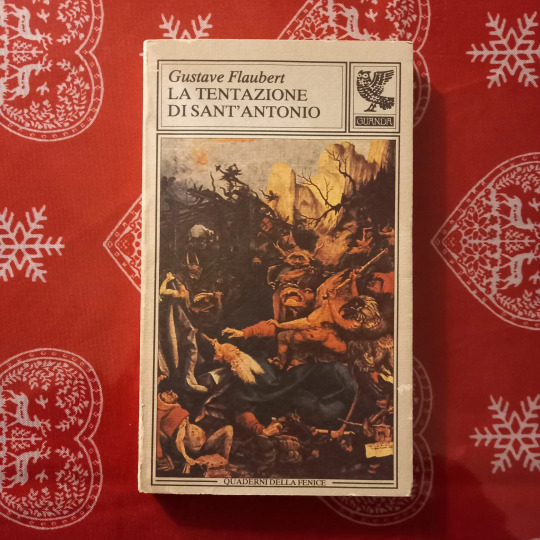#Claviceps purpurea
Text

Ergot-infected rye, 2023.
27 notes
·
View notes
Text

10 notes
·
View notes
Text
Poveștile pâinii: cum a înnebunit pâinea un întreg oraș în 1951
Ziua de Joi, 15 august 1951, a început în Pont-Saint-Esprit, un orășel din sudul Franței, situat la 30 de km de Avignon (orașul antipapilor sau altera Roma), asemeni oricărei alte zi liniștie din istoria localității. Pe la 10 dimineața un fermier a pătruns în cabinetul medicului local, Dr. Hadar Gabbai, într-o stare de panică, pretinzând că este atacat de un roi de albine. După câteva minute, un…

View On WordPress
0 notes
Text
Abati
Sant’Antonio Abate

In foto: Trittico delle Tentazioni di sant'Antonio di H. Bosch, 1501 ca., Museo del Prado, Madrid
Oggi 17 gennaio la Chiesa cattolica festeggia Sant’Antonio Abate. Nato a Coma, nel cuore dell'Egitto, intorno al 250 d.C., a vent'anni abbandonò ogni cosa per vivere vita anacoretica per più di 80 anni: secondo le cronache, morì nel 356 d.C., più che centenario. Riconosciuto già in vita come taumaturgo e in odore di santità, fu visitato da tantissimi pellegrini e bisognosi di tutto l'Oriente, tra cui si narra anche l'imperatore Costantino e i suoi figli. Fu un suo discepolo, sant'Atanasio, che raccontò la sua vita.
Nell'iconografia tradizionale è raffigurato circondato da donne provocanti, simbolo delle tentazioni, o animali domestici, come il maiale, di cui è popolare protettore. Nel culto spazio importante ha Il fuoco legata ad una particolare leggenda: si narra infatti che sceso all’Inferno per salvare delle anime dei peccatori, mentre il suo maiale portava scompiglio tra i diavoli, attinse la ferula (che diventerà simbolo nel bastone vescovile) nelle fiamme, portando il fuoco con sè.
I suoi discepoli tramandarono alla Chiesa la sua sapienza, raccolta in 120 detti e in 20 lettere; nella Lettera 8, Sant’Antonio scrisse ai suoi “Chiedete con cuore sincero quel grande Spirito di fuoco che io stesso ho ricevuto, ed esso vi sarà dato”. Nel 561 fu scoperto il suo sepolcro e le reliquie cominciarono un lungo viaggiare nel tempo, da Alessandria a Costantinopoli, fino in Francia nell’XI secolo a Motte-Saint-Didier, dove fu costruita una chiesa in suo onore. In questa chiesa a venerarne le reliquie, affluivano folle di malati, soprattutto di ergotismo canceroso, causato dall’avvelenamento di un fungo presente nella segale (si verifica per abuso terapeutico di essi o in forma epidemica, per l’uso di farine contaminate da polvere di sclerozi del fungo Claviceps purpurea), usata per fare il pane. Il morbo era conosciuto sin dall’antichità come “ignis sacer” per il bruciore che provocavano le cancrene ulcerose e per le allucinazioni; per ospitare tutti gli ammalati che giungevano, si costruì un ospedale e una Confraternita di religiosi, l’antico Ordine ospedaliero degli “Antoniani”; il villaggio prese il nome di Saint-Antoine di Viennois. Il Papa accordò loro il privilegio di allevare maiali per uso proprio e a spese della comunità, per cui i porcellini potevano circolare liberamente fra cortili e strade, nessuno li toccava se portavano una campanella di riconoscimento.
Il loro grasso veniva usato per curare l’ergotismo, che venne chiamato “il male di s. Antonio” e poi “fuoco di s. Antonio”. Tuttavia c’è da dire che le due malattie sono diverse, dato che quello che attualmente è chiamato Fuoco di sant’Antonio è causato dal virus della varicella infantile (varicella-zoster virus), e prese questo nome per l’invocazione al Santo come guarigione. Anche il maiale cominciò ad essere associato al Santo, nell’iconografia soprattutto mediterranea, tanto da essere considerato il santo patrono dei maiali e per estensione di tutti gli animali domestici e della stalla. Nella sua iconografia compare oltre al maialino con la campanella, anche il bastone degli eremiti a forma di T, la “tau” ultima lettera dell’alfabeto ebraico e quindi allusione alle cose ultime e al destino. Nel giorno della sua festa liturgica, si benedicono le stalle e si portano a benedire gli animali domestici e si accendono giganteschi falò a ricordo della sua impresa all’Inferno. In alcune zone, tipo alcuni comuni catanesi e nel napoletano, era tradizione comune mettere una icona del santo durante la costruzione dei forni, a protezione dell’uso del fuoco.
Molti gli artisti che l'hanno raffigurato:
Michelangelo Buonarroti, Il Tormento di Sant’Antonio (1487-1489)

Paul Cezanne, Tentazione di Sant’Antonio, 1875-1877

Salvador Dalì, Tentazione di Sant’Antonio, 1946

Gustave Flaubert pubblicò nel 1874 un libro, La Tentazione di Sant’Antonio, in cui l’eremita è tentato da seduzioni demoniache come lussuria, potere o ricerca del piacere. Ancora più inquietante è la comparsa di un suo discepolo, Ilarione, che gli presenta «tutti gli dèi, i riti, le preghiere e gli oracoli», e sottolinea le contraddizioni delle Sacre Scritture.

13 notes
·
View notes
Text
If someone’s special interest was Claviceps purpurea would you say they have ergotism
12 notes
·
View notes
Text
Why do witches ride broomsticks?
What comes to mind when you think of a witch? For most people, the first image that comes to mind is a witch flying across the night sky on a broomstick. But why in history were witches depicted flying on broomsticks?
While the image of a witch flying on a broomstick is the most common, the image of a witch standing over a bubbling cauldron preparing a potion is equally iconic. There is a great reason for this. The use of powerful hallucinogens was very popular at that time, which is closely related to the reason why witches were depicted flying on broomsticks.
At a time when witch hunts were gaining popularity in Europe, people ate large amounts of bread. At that time, bread was mainly made from rye, which was often infected with a disease called ergot, caused by the fungus Claviceps purpurea. As a result, many people have been ingesting ergot unknowingly, believing it to be part of the plant. Ergot has hallucinogenic properties, causing its users to experience LSD-like experiences.
Not surprisingly, many people liked the effect and began experimenting with it, as well as other plants that produced similar results. These include turmeric, mandrake, deadly nightshade and wild rosemary. Johannes Weyer, a Dutch physician, and occultist, in his 1563 work Praestigiis Daemonum called all these plants ingredients of the "flying ointment" of witches.
However, these hallucinogens also had unpleasant side effects. If swallowed, they caused rashes, nausea, vomiting, and even death. But some resourceful people quickly realized that besides ingestion, there are other ways to consume witches' brew that avoid these side effects. It was about the absorption of the drug through the skin. This is best done through the delicate mucous membrane under the armpits or, in the case of women, through the genitals.
These drugs were also studied by the 16th-century physician Andrés de Laguna. One day he took one of these potions from the home of a woman accused of witchcraft and tested it on another woman. According to de Laguna, the woman "fell into such a deep sleep that I thought I would never be able to wake her up." Fortunately, after 36 hours, it worked. The woman was incredibly nervous to be woken up.
This led Laguna to the following conclusion: "From all this, it can be concluded that everything these wretched witches do and say is caused by potions and ointments that have so corrupted their memory and imagination that they create their own misfortunes because they firmly believe when they wake up, into everything they dreamed of."
2 notes
·
View notes
Text
todays wikipedia article: claviceps purpurea, a fungus that grows on ears of cereal plants and when consumed can lead to hallucinations. its been theorized that the consumption of the ergot played a big part in certain religious rites, for example the eleusinian mysteries.

#the german word for this is mutterkorn (mothergrain) which i think is soo cool#which might be derived from the german word for uterus (birthingmother) because in small doses this fungus can also help with#period & birthing pains#:)
6 notes
·
View notes
Text


A preliminary study of Claviceps purpurea in culture
By Bonns, W. W. (Walter Weidenfeld), 1877-1954
0 notes
Text
So after making my realisation that i was limiting myself, i took some time away from my pieces to re-brainstorm what i saw as disease.
This brought me towards this list of directions:
.Nature taking over the human form
.Metal taking over human form
.Disease in a positive light , re growth after death
On this day we also had a lecture that spoke about ergotism which was a form of poisoning that comes from consumption of the “ascomycete fungus Claviceps purpurea” interestingly we were also informed it is the same fungus from which the drug LSD is made.
I thought maybe, a visual to express how addiction itself is a disease may be interesting to explore.
I cannot guarantee what ones of these will find their way further on into my project but i am very excited to explore all of them.
1 note
·
View note
Link
by thestrangehouse
Mu Qing can see both sounds and, uh, orgasms.
But other than that he's a perfectly normal guy, he swears!
Normal job, normal hobbies, normal annoyingly handsome intern he has to oversee.
Words: 2008, Chapters: 1/2, Language: English
Fandoms: 天官赐福 - 墨香铜臭 | Tiān Guān Cì Fú - Mòxiāng Tóngxiù
Rating: Explicit
Warnings: Creator Chose Not To Use Archive Warnings
Categories: M/M
Characters: Fēng Xìn (Tiān Guān Cì Fú), Mù Qíng (Tiān Guān Cì Fú)
Relationships: Fēng Xìn/Mù Qíng (Tiān Guān Cì Fú)
Additional Tags: Alternate Universe - Modern Setting, Synesthesia, Other Additional Tags to Be Added, The Author Regrets Everything, Ableism
1 note
·
View note
Link
by thestrangehouse
Mu Qing can see both sounds and, uh, orgasms.
But other than that he's a perfectly normal guy, he swears!
Normal job, normal hobbies, normal annoyingly handsome intern he has to oversee.
Words: 2008, Chapters: 1/2, Language: English
Fandoms: 天官赐福 - 墨香铜臭 | Tiān Guān Cì Fú - Mòxiāng Tóngxiù
Rating: Explicit
Warnings: Creator Chose Not To Use Archive Warnings
Categories: M/M
Characters: Fēng Xìn (Tiān Guān Cì Fú), Mù Qíng (Tiān Guān Cì Fú)
Relationships: Fēng Xìn/Mù Qíng (Tiān Guān Cì Fú)
Additional Tags: Alternate Universe - Modern Setting, Synesthesia, Other Additional Tags to Be Added, The Author Regrets Everything, Ableism
1 note
·
View note
Text
Destruction of 50% maize plants in USA (1970) due to infection of
(a) Hemileia vastratrix
(b) Helminthosporium oryzae
(c) Claviceps purpurea
(d) Ustilago maydis
Answer. (d)
View On WordPress
0 notes
Text
D-Lysergic Acid Diethylamide or ‘LSD’ is part of the pharmacological group known as “classical hallucinogens” or “psychedelics”, which share its chemical structure with psilocybin and dimethyltryptamine (DMT) as a variant of indolamine (chemical structure similar to the neurotransmitter serotonin).
• LSD is the most potent and notorious of the hallucinogens, and the one that brought this class of drugs into the public eye in the 1960’s. LSD Tabs was originally synthesized from ergot alkaloids extracted from the ergot fungus Claviceps purpurea.
• D-Lysergic Acid Diethylamide (LSD) is an odourless, colourless, and is slightly bitter tasting.
• LSD acts primarily as a serotonergic agonist as well influencing other neurotransmitter systems via dopaminergic and adrenergic receptors. LSD triggers an increase in cortisol, oxytocin, and adrenaline levels. The predominant effects induced by LSD included visual hallucinations, audiovisual synesthesia, and positively experienced derealization and depersonalization phenomena.
0 notes
Text
What does ergothioneine do to the skin?
What is l-ergothioneine?
Ergothioneine (mercaptohistidine trimethyl inner salt, ergothioneine, EGT) is a natural antioxidant that can protect cells in the human body and is an important active substance in the body. Natural antioxidants are safe and non-toxic, and have become a research hotspot. As a natural antioxidant, ergothioneine has entered people's field of vision. It has various physiological functions such as scavenging free radicals, detoxification, maintaining DNA biosynthesis, normal cell growth and cellular immunity.
Ergothioneine is distributed in some tissues and organs of mammals, mainly in red blood cells (about 1-2 mmol.L) and the semen of some animals. Although no experimental studies have shown that animals can synthesize this substance, but There must be pathways for the absorption and retention of ergothioneine in animal cells. For carnivores, ergothioneine in animal tissues can supply dietary needs.
The essence of ergothioneine is a natural and rare amino acid, which was first discovered by French pharmacist Charles Tanret in 1909 when investigating the ergot fungus Claviceps purpurea, and then scientific research found that ergothioneine also exists in human and other animal tissues.
Since ergothioneine was discovered in animal tissues, scientists have conducted more in-depth research on ergothioneine and found that it can effectively scavenge free radicals (the main factor causing human aging), protect cell membranes and mitochondrial membranes from immune Various functions such as oxidative damage, cell protection and anti-ultraviolet radiation.
What does ergothioneine supplement do to the skin?

The cosmetics industry is the most widely used field of ergothioneine. In recent years, one of the important driving forces for the rapid development of China's ergothioneine market is because of the wider application of ergothioneine in the cosmetics industry.
The main role of ergothioneine in the skin care industry is to whiten and remove freckles and act as an antioxidant. With a risk factor of 1, it is very safe, non-comedogenic, and non-irritating to pregnant women.
Ergothioneine is an imidazole alkaloid that widely exists in human blood, liver and internal organs, bacteria and plants, and has vitamin-like effects. It has been produced by synthetic method. Ergothioneine has coenzyme-like properties and participates in various biochemical activities of the human body. When applied externally to the skin, it can increase the activity of cortical cells and has anti-aging effects. Ergothioneine can inhibit the activity of melanocytes, reduce the production of melanin, and has a synergistic effect with human placenta extract. Ergothioneine has strong antioxidant properties, absorbs UV light in the D-zone, and can increase skin lightening effect.
Its role can be roughly summarized as the following points:
1. Antioxidant effect
It has the effect of antioxidants, and can also effectively remove hypochlorous acid, thereby preventing the loss of a 1-antiprotease. However, it cannot inhibit the peroxidation of lipid particles in the presence of iron ions.
2. Protective effect on cells
Ergothioneine is a powerful hypochlorous acid scavenger (HOCl), and while many compounds react with hypochlorous acid, few react as rapidly as ergothioneine. It protects red blood cells from neutrophils from either normal function or from sites of pathological inflammation.
3. Anti-inflammatory effect
Ergothioneine can inhibit peroxynitrite-mediated amino acid oxidation, such as tyrosine nitration, thus providing feasibility for the treatment of inflammation.
4. Other biological functions
It has strong antioxidant activity: scavenging reactive oxygen species, chelating divalent metal ions, activating antioxidant enzymes, inhibiting superoxide dismutase, inhibiting the oxidation of various heme proteins, etc.
0 notes
Text
Destination Moon Palace
Destination Moon Palace is a 5e compatible adventure for four to six adventurers of level 7. It continues the story started in Moon Elves’ Masquerade by examining what the deposed Moon Prince, Claviceps Purpurea did after his downfall. The adventure can be run in 3 – 4 hours and takes place in both the Moon and Hell. While on the moon, the PCs’ jump distance is tripled and they take no damage…

View On WordPress
0 notes